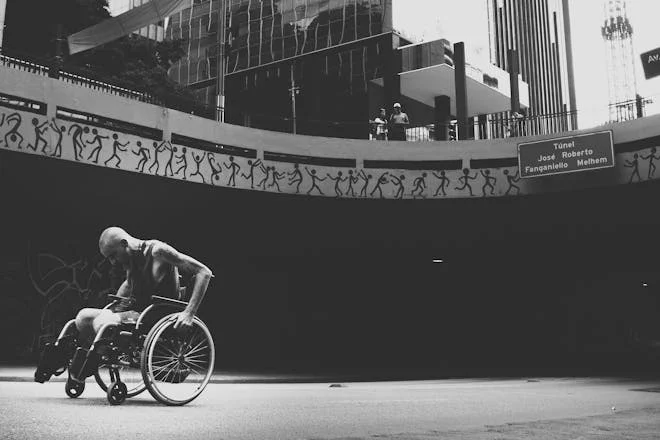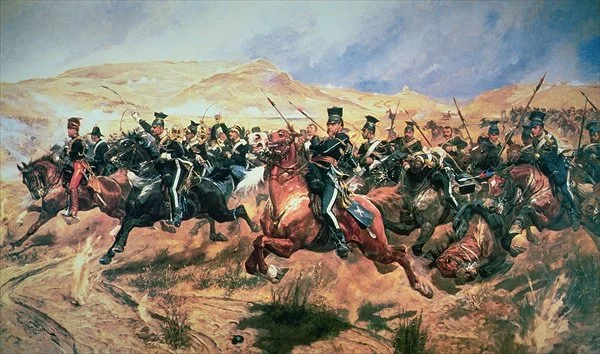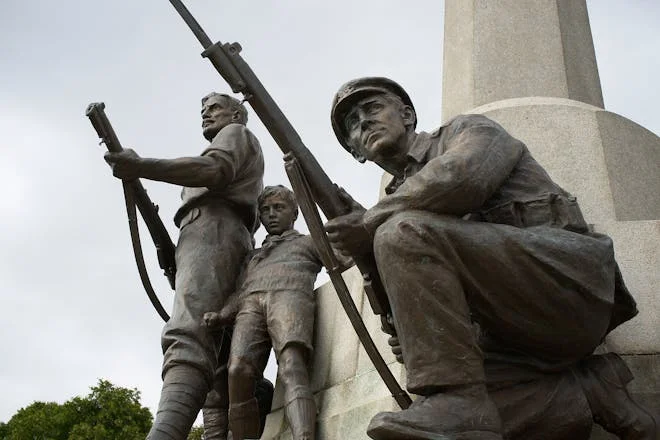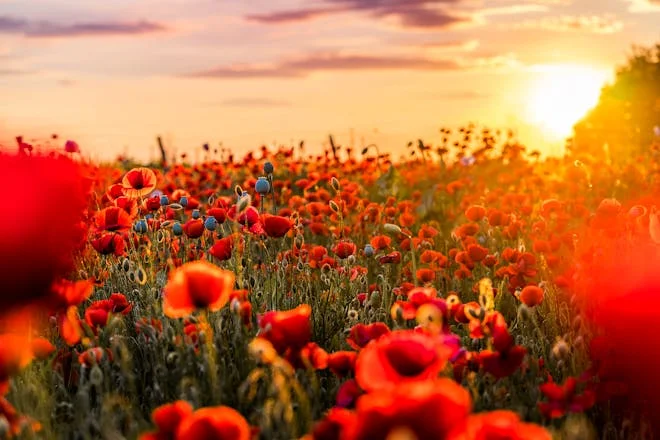
Written by Canadian physician Lieutenant Colonel John McCrae during World War I, “In Flanders Fields” is one of the most iconic war poems. First published in December 1915 in Punch magazine, the poem has become a lasting symbol of the sacrifices made during the Great War.
McCrae composed the poem after witnessing the death of his friend, Alexis Helmer, at the Second Battle of Ypres, giving it deep emotional resonance. This blog post provides a comprehensive analysis of “In Flanders Fields,” exploring its subject matter, context, themes, tone, form, and structure to understand its enduring impact and relevance.
In Flanders Fields
John McCrae
In Flanders' fields the poppies blow
Between the crosses, row on row,
That mark our place: and in the sky
The larks, still bravely singing, fly
Scarce heard amid the guns below.
We are the dead. Short days ago
We lived, felt dawn, saw sunset glow,
Loved and were loved, and now we lie
In Flanders' fields.
Take up our quarrel with the foe;
To you from failing hands we throw
The torch; be yours to hold it high,
If ye break faith with us who die
We shall not sleep, though poppies grow
In Flanders' Fields.
Content
- About the Author: John McCrae
- Subject of "In Flanders Fields"
- Context of "In Flanders Fields"
- Theme and Tone of "In Flanders Fields"
- Structure and Form of "In Flanders Fields"
- Persona, Setting, and Narrative
- Line-by-Line Analysis of "In Flanders Fields"
- Poetic and Literary Devices Used in "In Flanders Fields"
- Implications and Meanings of "In Flanders Fields"
- Interactive Summary
- Influence and Legacy
- Conclusion
About the Author: John McCrae
John McCrae, a Canadian poet, physician, and soldier, is renowned for his contributions to war poetry. Born on November 30, 1872, in Guelph, Ontario, McCrae excelled academically, earning a medical degree from the University of Toronto. His career bridged both medicine and literature, shaping his multifaceted legacy.
During World War I, McCrae served as a brigade surgeon with the Canadian Expeditionary Force, experiencing the horrors of trench warfare firsthand. The death of his friend, Lieutenant Alexis Helmer, during the Second Battle of Ypres in 1915 inspired him to write “In Flanders Fields.” The poem deeply resonated with the public and captured the collective grief of the war.
McCrae’s poetry reflects themes of sacrifice, honor, and remembrance. “In Flanders Fields” remains a powerful symbol of World War I, showcasing his ability to convey deep emotions. His legacy endures through his heartfelt reflections on the human experience during troubled times.
Subject of “In Flanders Fields”
“In Flanders Fields” by John McCrae addresses the tragic realities of World War I and the sacrifices of soldiers. The poem is set in Flanders, a region in Belgium that saw intense fighting, and centers around the graves of fallen soldiers. McCrae highlights the contrast between life and death by depicting poppies blooming amid the devastation of war. These poppies symbolize the enduring legacy of those who fought and died.
The poem opens with a serene image of poppies growing among graves marked by crosses, representing the soldiers who have perished. The voices in the poem are those of the dead soldiers, speaking from beyond the grave. They recount their recent experiences of life—feeling the warmth of dawn, seeing the sunset, and experiencing love. This highlights their humanity and the lives they left behind.
In the final stanza, the poem shifts to a call to action for the living. The dead urge the survivors to “take up our quarrel with the foe,” encouraging them to continue the fight and uphold the causes for which the soldiers died. This emphasizes the importance of honoring their sacrifice and continuing their struggle for justice and freedom. This passing of the torch signifies the ongoing duty and responsibility of the living to honor the fallen soldiers by preserving their memory and continuing their fight.
McCrae’s poem emphasizes not just the soldiers’ deaths but also the living’s obligation to remember and continue the fight for freedom and peace. The poppies have since become a universal emblem of remembrance for soldiers who have died in war, especially in the context of World War I. “In Flanders Fields” reflects on sacrifice, memory, and the duty of the living to honor the legacy of the fallen.
Context of “In Flanders Fields”
“In Flanders Fields” was written by John McCrae during World War I, which lasted from 1914 to 1918 and brought unprecedented devastation. McCrae composed this poem on May 3, 1915, during the Second Battle of Ypres, one of the war’s most brutal engagements. Hence, this context is crucial for understanding the poem’s emotional depth and profound sense of loss.
McCrae, serving as a surgeon with the Canadian Expeditionary Force in Belgium, was deeply affected by the death of his friend and former student, Lieutenant Alexis Helmer, killed by a German artillery shell. Helmer’s burial was particularly emotional for McCrae. Observing the wild poppies growing among the newly dug graves, he was inspired to write “In Flanders Fields” the next day.
The poem captured the collective grief and resolve of soldiers and civilians alike. Published in the British magazine Punch on December 8, 1915, it resonated deeply with those experiencing the war’s toll. It quickly became emblematic of soldiers’ sacrifices and the importance of remembrance.
World War I, characterized by trench warfare and massive casualties, significantly influenced the poem’s reception and legacy. Against this backdrop, McCrae’s poem serves as a reminder of the human cost of war and the duty to honor the fallen. The use of poppies in the poem contributed to their adoption as a symbol of remembrance, a tradition that continues today.
Theme and Tone of “In Flanders Fields”
Theme
The central theme of “In Flanders Fields” revolves around remembrance and sacrifice. The poem serves as a reminder of the lives lost during World War I, particularly in the region of Flanders. It emphasizes the duty of the living to honor the memory of the fallen soldiers who gave their lives in service. The theme of remembrance is intricately tied to the image of poppies, which have become a symbol of commemoration for those who died in war.
Another theme present in the poem is the continuity of duty. The fallen soldiers, speaking from beyond the grave, urge the living to “take up our quarrel with the foe” and continue the fight. This theme emphasizes the idea that future generations must not forget the sacrifices made by earlier ones, but rather carry them forward. Moreover, it highlights the ongoing struggle for freedom and justice, ensuring that the legacy of the fallen remains alive.
Furthermore, the poem speaks about the cycle of life and death. Through the imagery of nature—poppies growing and larks singing—the poem juxtaposes the beauty and persistence of life with the inevitability of death. This cycle reinforces the idea that while individuals may perish, the causes they fought for endure, carried on by the living.
Tone
The tone of “In Flanders Fields” is sorrowful yet resolute. The poem conveys a deep sense of loss and mourning for the soldiers who perished in war. This sorrow is visible in the imagery of crosses marking the graves and the mention of loved ones left behind. However, amidst this sorrow, there is a strong tone of determination and resolve. Accordingly, the dead soldiers, through their words, urge the living to continue the fight and uphold the values for which they sacrificed their lives.
The tone also carries a sense of reverence and reflection. The poem pays homage to the fallen soldiers, honoring their courage and commitment. McCrae portrays the poppies blowing in the fields with solemnity, symbolizing both the beauty of life and the transience of human existence. Thus, the reflective tone encourages readers to contemplate the cost of war and its lasting impact on individuals and societies.
Structure and Form of “In Flanders Fields”
Structure
“In Flanders Fields” by John McCrae is a rondeau, a fixed form of poetry that is characterized by its structure and rhyming scheme. Understanding the structure and form of the poem enhances our appreciation of its rhythmic qualities and thematic depth.
The poem consists of three stanzas with a total of 15 lines. The first stanza has five lines, the second has four, and the third returns to six lines. This structure is typical of a rondeau, which traditionally follows a 15-line pattern divided into these stanzas.
Form
The rondeau form McCrae uses is defined by its distinctive rhyme scheme and the repetition of the refrain. The rhyme scheme of “In Flanders Fields” is AABBA AABC AABBAC. This pattern creates a melodic and cyclical feel, which reinforces the themes of remembrance and the cyclical nature of life and death.
The poem also includes a refrain, a repeated phrase that is integrated into the poem’s structure. In this case, “In Flanders fields” serves as the refrain, appearing at the end of the first and last stanzas, and also in the middle of the poem. The repetition of this line emphasizes the setting and the solemn message of the poem, anchoring the reader in the field of poppies and crosses.
Pauses and Line Breaks
McCrae’s use of pauses and line breaks is deliberate and impactful. The line breaks often coincide with natural pauses, creating a somber and reflective pace. For example, the break after “We are the Dead. Short days ago” (line 6) creates a pause that highlights the suddenness of the soldiers’ transition from life to death.
Punctuation
The poem features a moderate amount of punctuation, which helps to guide the reader’s rhythm and pace. Commas and periods are used to create pauses and separate ideas, while the semicolon in “That mark our place; and in the sky” (line 3) links two related thoughts, enhancing the flow of the poem.
Consistent Rhyme
The consistent rhyme scheme (AABBA AABC AABBAC) contributes to the poem’s musicality. The regularity of the rhyme scheme mirrors the uniformity of the rows of crosses and the endless repetition of loss in war. This consistency also helps to reinforce the poem’s themes, making the message more memorable.
Meter
The meter of “In Flanders Fields” contributes significantly to its reflective and solemn tone. McCrae employs a mixture of iambic and anapestic meter, creating a rhythm that mimics the natural flow of speech while maintaining a poetic cadence. The iambic meter, with its unstressed-stressed pattern, is predominant, lending a steady, marching rhythm that mirrors the soldiers’ march to war and the inevitability of their fate. This metrical pattern helps to highlight the solemnity and gravity of the poem’s subject matter.
Persona, Setting, and Narrative
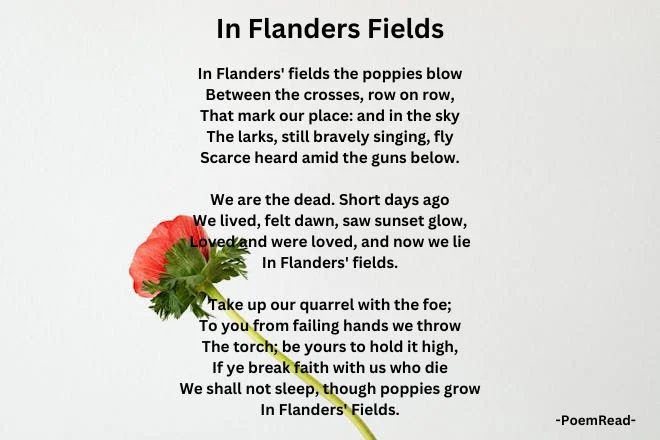
Persona
The persona in “In Flanders Fields” is the collective voice of the fallen soldiers. This choice gives the poem a powerful and moving perspective by having the dead speak directly to the living. By using the first-person plural, “We are the Dead,” McCrae effectively conveys the shared experience and sacrifice of the soldiers who perished in the war.
This collective voice emphasizes unity and common purpose, adding emotional depth and a sense of urgency to the poem’s message. Furthermore, the use of this persona makes the poem deeply personal and evocative, directly connecting the reader with the experiences and pleas of the deceased soldiers.
Setting
The setting of “In Flanders Fields” is a battlefield in Flanders, Belgium, during World War I. This area was the site of some of the most intense and deadly fighting of the war. The poem focuses specifically on the cross-marked burial grounds for soldiers.
The imagery of poppies blowing in the wind among these graves creates a stark contrast between the beauty of nature and the horrors of war. This juxtaposition highlights the tragic loss of life and the serene yet somber environment that surrounds the soldiers’ final resting places. The setting is crucial, as it grounds the poem in a real and devastating historical context, enhancing its emotional impact.
Narrative
The narrative of “In Flanders Fields” unfolds in three stanzas, each with a distinct focus. The first stanza sets the scene, describing the poppies growing among the graves of soldiers. The imagery of larks singing amid the sounds of battle introduces the theme of life’s persistence even in the face of death.
The second stanza shifts to the voices of the dead soldiers, who reflect on their recent past lives filled with experiences of dawn, sunset, and love. This recollection underscores their humanity and the full, vibrant lives they led before their untimely deaths.
The third stanza is a call to action. The dead implore the living to continue the fight, urging them to take up their cause and not let their sacrifice be in vain. The narrative moves from a reflection on death and loss to a powerful appeal for remembrance and the continuation of the struggle. This progression creates a sense of duty and responsibility, highlighting the ongoing impact of the soldiers’ sacrifice and the importance of honoring their legacy.
Line-by-Line Analysis of “In Flanders Fields”
First Stanza
The first stanza sets the scene in Flanders fields, where poppies blow between rows of crosses marking the graves of fallen soldiers. The presence of the larks singing in the sky above, though barely heard over the sounds of battle, juxtaposes the beauty of nature with the harsh reality of war. The opening stanza sets a somber tone and introduces imagery that runs through the poem, emphasizing the magnitude of loss and the endurance of life amid death.
Key Points:
- Imagery of Poppies: Symbolizes both life and death.
- Crosses “Row on Row”: Emphasizes the vast number of casualties.
- Larks Singing: Represents the resilience of life despite the surrounding death.
- Guns Below: Highlights the ongoing conflict and the brutality of war.
“In Flanders fields the poppies blow”
The poem opens with a vivid image of poppies blowing in the fields of Flanders. This specific location anchors the poem in historical context of war-torn landscapes of Belgium. Poppies are symbolic of both sleep and death, setting a somber tone. Therefore, this line establishes a stark contrast between the natural beauty of the poppies and the underlying tragedy of the setting. Additionally, the use of “blow” suggests movement and life, contrasting with the death around them.
“Between the crosses, row on row,”
This line highlights the orderly arrangement of crosses marking the graves of fallen soldiers. The repetition of “row on row” emphasizes the vast number of casualties, creating a visual representation of the scale of loss. Furthermore, this emphasizes the vastness of the loss and the uniformity of the soldiers’ sacrifices, conveying a sense of solemnity and respect.
“That mark our place; and in the sky”
The crosses “mark our place,” indicating the resting spots of the dead. The line shifts upward to the sky, introducing a sense of elevation or transcendence, possibly hinting at the souls of the fallen.
“The larks, still bravely singing, fly”
Larks in “In Flanders Fields” symbolize life and hope. The poem personifies them, attributing human-like bravery to the larks. Despite the chaos of war and the gunfire below, the larks persist in singing and flying. This contrast between the peaceful song of the larks and the violence of war highlights their resilience and the enduring presence of life amidst death.
“Scarce heard amid the guns below.”
The sound of the larks, barely audible over gunfire, highlights the brutality of war and the delicate beauty of nature struggling to be noticed. The mention of “guns below” serves as a stark reminder of ongoing conflict. McCrae’s choice of “still” implies the relentless nature of warfare, creating tension between nature’s serenity and human brutality. The word “scarce” emphasizes this irony even more by highlighting how weak their song is in the face of violence.
Second Stanza
In the second stanza, the perspective shifts to the voices of the dead soldiers, who reflect on their recent experiences of life. They recount their time living, feeling the dawn, seeing sunsets, loving, and being loved, only to now lie in Flanders fields. This stanza personalizes the loss, turning the abstract notion of fallen soldiers into a more intimate and poignant reality.
Key Points:
- Voice of the Dead: Gives a personal and emotional dimension to the fallen.
- Recalling Life: Highlights the normal, everyday experiences of the soldiers.
- Contrast with Death: The juxtaposition of life’s beauty with the finality of death.
“We are the Dead. Short days ago”
The poem shifts to the voices of the fallen soldiers, speaking directly to the reader. This line establishes their identity as “the Dead,” creating an immediate and emotional connection. The phrase “short days ago” highlights the abruptness of their transition from life to death, emphasizing how recently they were alive.
“We lived, felt dawn, saw sunset glow,”
Here, the soldiers recount their recent experiences of life. The actions “lived,” “felt dawn,” and “saw sunset glow” symbolize the entire span of a day, representing the entirety of a human life. This line highlights the normalcy and beauty of their daily existence before the war, making their loss more tangible and personal.
“Loved and were loved, and now we lie,”
This line continues the reflection on their past lives, focusing on the emotional connections they had. The repetition of “loved” emphasizes the mutual affection they experienced, adding a layer of intimacy and humanity. The sudden shift to “and now we lie” starkly contrasts their earlier vitality with their current state of death, intensifying the sense of loss.
“In Flanders fields.”
The refrain “In Flanders fields” serves as a somber reminder of their resting place. This repetition solidifies the stanza in its setting, reinforcing the reality of their sacrifice. It ties their individual stories back to the collective tragedy of the war, highlighting the common fate shared by many.
Third Stanza
The final stanza is a call to action directed at the living. The dead soldiers ask the living to “take up our quarrel with the foe” and carry on their fight. They pass the metaphorical torch, symbolizing duty and legacy, urging the living to hold it high. The stanza concludes with a warning: if the living betray the trust of the fallen, the dead will not find peace, despite the continued growth of poppies in Flanders fields.
Key Points:
- Call to Action: The dead urge the living to continue the fight.
- Passing the Torch: Represents the transfer of duty and responsibility.
- Warning: Emphasizes the importance of honoring the fallen by continuing their struggle.
- Symbolism of Poppies: Reminds readers of the ongoing significance of remembrance.
“Take up our quarrel with the foe:”
The fallen soldiers call upon the living to continue the fight against their enemies. The word “quarrel” suggests that this conflict is not just a battle but a moral and righteous cause. This line sets a tone of urgency and responsibility, urging the reader to take action.
“To you from failing hands we throw”
Here, the soldiers pass the metaphorical torch to the living. The phrase “failing hands” highlights their dying state, making the transfer of duty poignant and urgent. It emphasizes the fragility of life and the critical need for the living to carry on their mission.
“The torch; be yours to hold it high.”
The torch symbolizes the values, duties, and responsibilities that the dead soldiers upheld. “Be yours to hold it high” is a command to honor and maintain these principles with pride and determination. This line calls for resilience and steadfastness in the face of adversity.
“If ye break faith with us who die”
The soldiers warn the living about the consequences of not upholding their legacy. “Breaking faith” implies betrayal and neglect of the sacrifices made by the dead. This line instills a sense of accountability and moral obligation in the reader.
“We shall not sleep, though poppies grow”
The dead will not rest peacefully if their legacy is forgotten. The phrase “though poppies grow” symbolizes the continuous cycle of life and death represented by the poppies. It also emphasizes the unrest of the soldiers’ spirits if their sacrifice is deemed futile or goes unrecognized.
“In Flanders fields.”
The repetition of the refrain “In Flanders fields” ties the stanza back to the poem’s setting. It reinforces the importance of remembering where the soldiers lie and the significance of their sacrifice. This closing line reaffirms the solemn and haunting atmosphere established throughout the poem.
Poetic and Literary Devices Used in “In Flanders Fields”
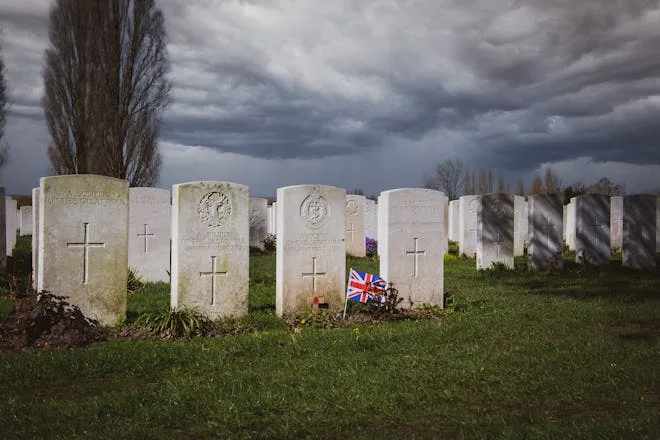
Imagery
John McCrae employs vivid imagery to create a powerful visual and emotional impact. The opening line, “In Flanders fields the poppies blow,” immediately paints a picture of the red poppies swaying in the wind among the graves. This image of delicate flowers amidst rows of crosses evokes the themes of life, death, and remembrance. Similarly, the imagery of larks singing bravely above the battlefield contrasts the tranquility of nature with the horrors of war, enhancing the poignancy of the scene.
Symbolism
Symbolism plays a crucial role in conveying the deeper meanings within the poem. The red poppies stand for both the blood that soldiers shed and the tenacity of life in the face of death. The crosses represent the graves of the fallen, marking the sacrifice of countless lives. The torch mentioned in the final stanza symbolizes the duty and legacy passed from the dead to the living, urging them to continue the fight and uphold the values for which the soldiers died.
Repetition
Repetition is used effectively to reinforce key themes and create a rhythmic structure. The phrase “In Flanders fields” is repeated at the end of the first and last stanzas, anchoring the poem in its setting and reinforcing the theme of remembrance. The repetition of “loved and were loved” emphasizes the emotional connections and humanity of the fallen soldiers, making their loss more personal and profound.
Alliteration and Assonance
McCrae employs alliteration and assonance to add musicality and enhance the poem’s rhythm. Examples include “Flanders fields” and “poppies blow,” where the repetition of consonant and vowel sounds creates a melodic quality. This use of sound devices not only makes the poem more pleasant to read aloud but also emphasizes important phrases and themes.
Personification
The poem uses personification to give human qualities to abstract concepts and elements of nature. The larks are described as “bravely singing,” attributing them with the human characteristic of bravery. This personification highlights the contrast between the resilience of the natural world and the human tragedy unfolding below. Additionally, the dead soldiers are given a voice, urging the living to carry on their struggle. This personifies their enduring spirit and determination.
Contrast
Contrast is a powerful device in the poem, highlighting the stark differences between elements to emphasize the poem’s themes. The serene image of larks singing amidst the chaotic sounds of gunfire underscores the brutality of war against the backdrop of nature’s beauty. The contrast between the soldiers’ past experiences of life (“felt dawn, saw sunset glow”) and their current state of death (“and now we lie”) illustrates the abruptness and tragedy of their loss.
Metaphor
Metaphors are used to convey abstract ideas through concrete images. The “torch” in the final stanza is a metaphor for the values, duty, and legacy that the dead soldiers are passing on to the living. This metaphor emphasizes the responsibility of the living to honor and uphold these ideals, creating a sense of continuity and purpose.
Rhyme and Rondeau Form
The poem’s structure follows the rondeau form, characterized by its specific rhyme scheme (AABBA AABC AABBAC) and refrain. This form, along with the consistent rhyme, contributes to the poem’s musicality and cohesiveness. The rhyme scheme establishes a rhythmic flow that mirrors the cycles of life and death. Meanwhile, the repetition of “In Flanders fields” fortifies the poem and reinforces its central themes.
Implications and Meanings of “In Flanders Fields”
“In Flanders Fields” carries powerful implications and meanings, reflecting on the themes of sacrifice, duty, and remembrance. The poem highlights the immense human cost of war, presenting a powerful tribute to those who lost their lives. The imagery of poppies growing among the graves serves as a reminder of the bloodshed and the new life that continues in its wake. This duality highlights the resilience of nature and the enduring spirit of humanity.
In the last stanza, the speaker is urging the reader to “take up our quarrel with the foe” in order to keep fighting for freedom and justice. It emphasizes that the fallen soldiers’ sacrifice must not be in vain, urging the reader to uphold the values for which they died. This passing of the torch symbolizes the continuity of duty and the collective effort required to maintain peace and honor.
Moreover, “In Flanders Fields” has transcended its wartime context to become a universal symbol of remembrance. Inspired by McCrae’s words, the poppy has become widely recognized as a symbol of remembrance for war veterans. Consequently, it serves as a reminder to honor the past while working towards a more peaceful future. The poem’s lasting legacy stems from its capacity to inspire reflection, foster respect, and cultivate a commitment to remembering those who gave their lives in conflict..
Interactive Summary
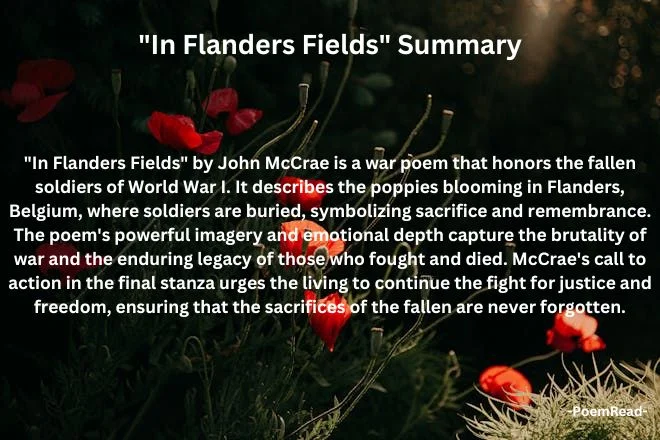
“In Flanders Fields” by John McCrae is a powerful and moving poem that invites readers to reflect on the sacrifices made by soldiers during World War I. The poem sets a vivid scene in Flanders, where red poppies blow gently in the wind among rows of crosses marking the graves of fallen soldiers. This peaceful and natural beauty starkly contrasts with the violence and death of war.
The poem gives voice to the fallen soldiers, who speak directly to the reader. They remind us that not long ago, they were alive, experiencing the same joys and sorrows as we do—seeing the dawn, feeling the warmth of the sun, loving and being loved. This personal connection makes their loss more poignant and real.
The soldiers then pass a metaphorical torch to the living, asking us to continue their fight. They urge us not to forget them and to carry on the struggle for justice and peace. This call to action emphasizes the importance of honoring their sacrifice by upholding the values they fought for.
The poppies growing in Flanders Fields have become a symbol of remembrance, representing both the bloodshed of the soldiers and the hope for new life and peace. By engaging with “In Flanders Fields,” we are reminded of the personal and collective costs of war, and the poem encourages us to remember and honor those who have fallen by continuing their legacy. This reflection on the poem underscores the responsibilities we have toward past and future generations.
Influence and Legacy
“In Flanders Fields” has left an unforgettable mark on both literature and cultural memory. The poem’s striking imagery and moving themes have resonated deeply with readers since its publication. It quickly became a symbol of the sacrifices made during World War I and has since been recited at countless memorial services and commemorative events around the world.
One of the most significant impacts of McCrae’s poem is the adoption of the poppy as a symbol of remembrance. Inspired by McCrae’s words, American professor Moina Michael initiated the tradition of wearing poppies to honor fallen soldiers. This practice spread internationally, particularly throughout the Commonwealth, and remains a powerful symbol of remembrance to this day.
The legacy of “In Flanders Fields” extends beyond its role in memorializing war. It has influenced generations of poets and writers, inspiring works that explore the themes of war, sacrifice, and remembrance. The poem’s enduring relevance underscores the universal and timeless nature of its message.
Conclusion
In conclusion, “In Flanders Fields” by John McCrae is a powerful tribute to the fallen soldiers of World War I. Its powerful imagery, deep themes, and heartfelt call to action have solidified its position in literary and cultural history. The poem not only honors those who sacrificed their lives but also serves as a reminder of our ongoing responsibility to uphold the values they fought for.
The enduring symbol of the poppy, intertwined with McCrae’s words, stirs deep reflection and heartfelt remembrance. Together, they ensure that the legacy of those who rest in Flanders Fields is forever cherished and honored.
If “In Flanders Fields” intrigues you, you’ll also find our analysis of “Dolce et Decorum Est” captivating. It delves into the raw realities of war and challenges conventional perceptions of heroism. Dive into our exploration to uncover the haunting truths behind the battlefield experience.
RELATED POSTS
View all

